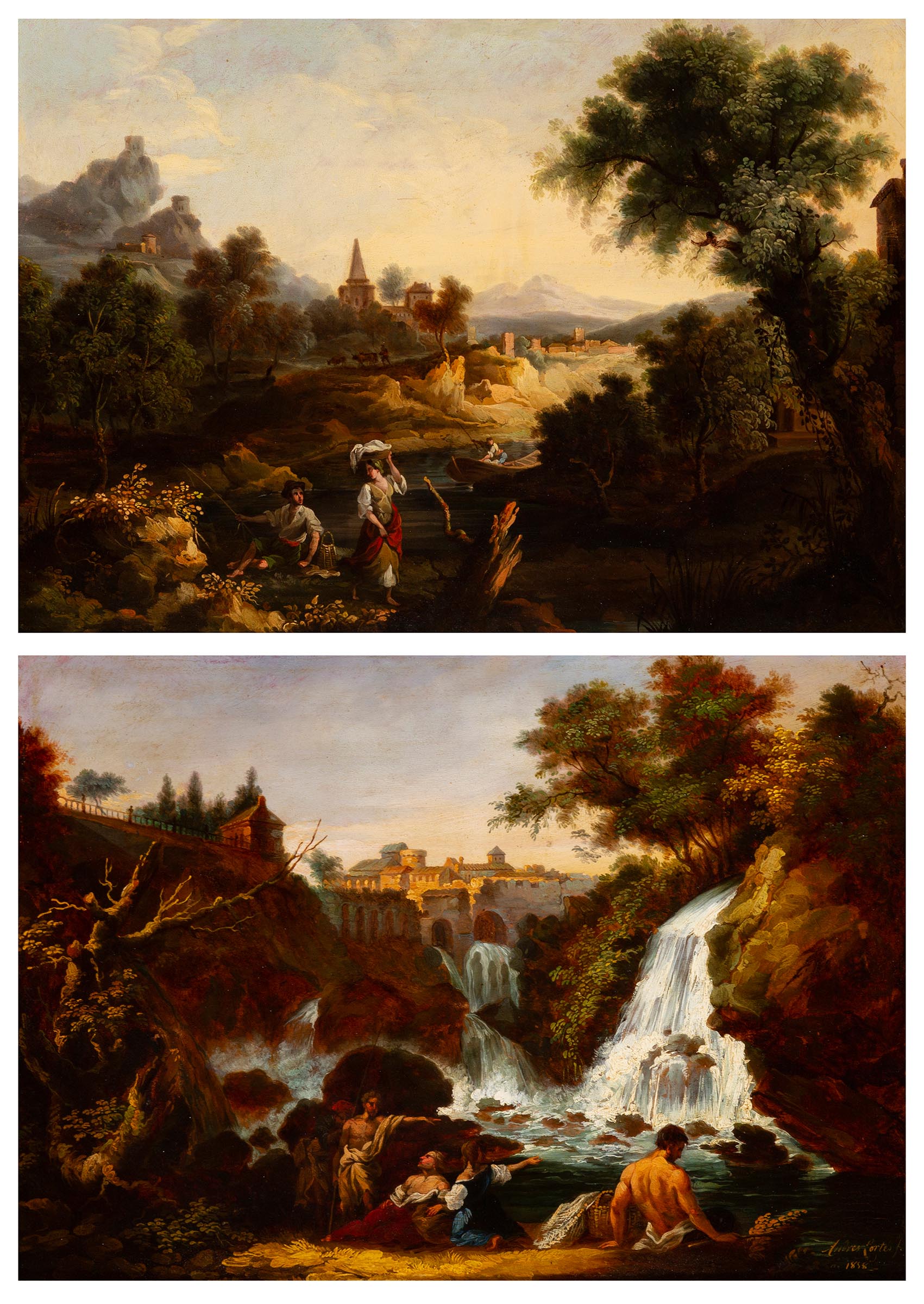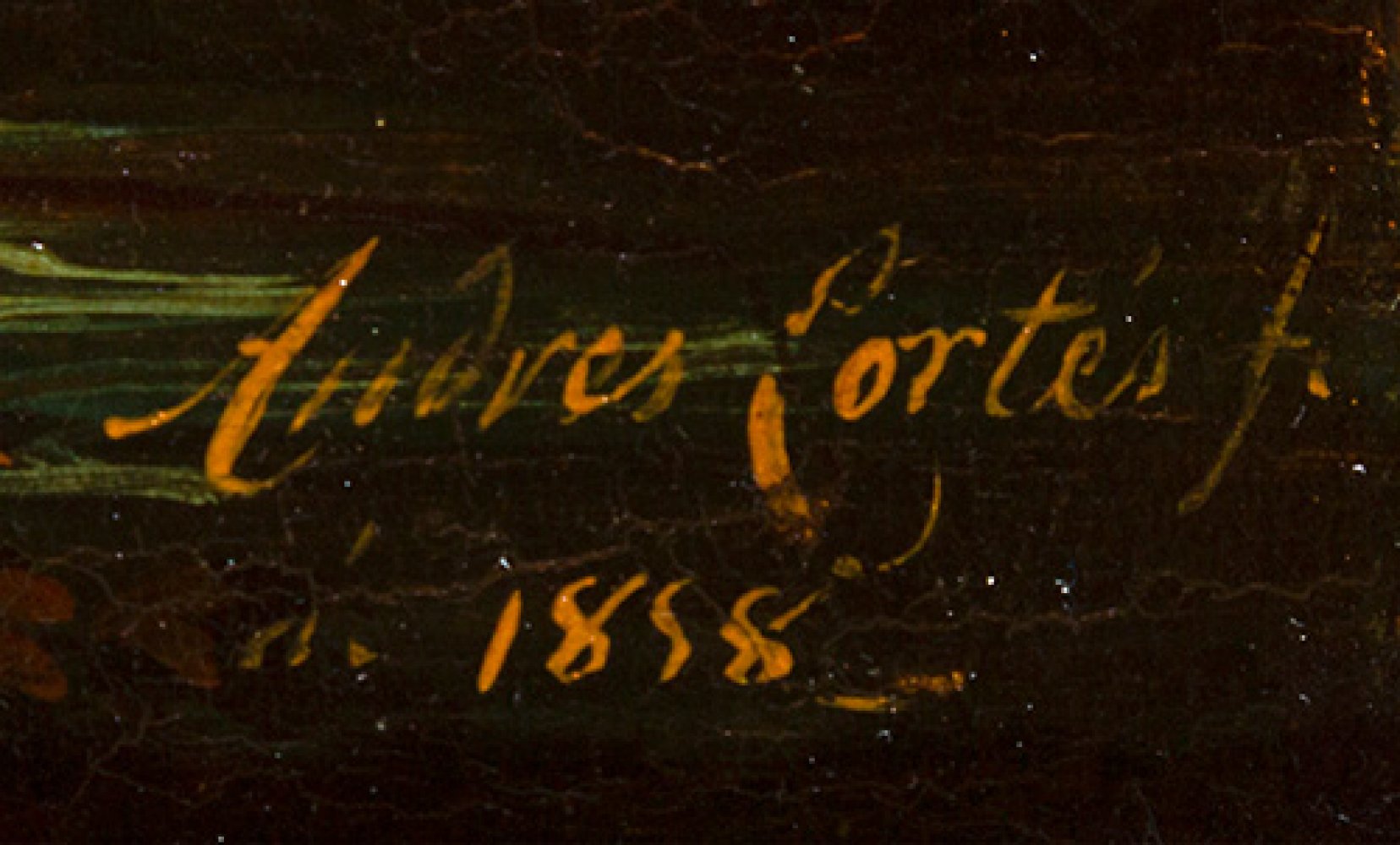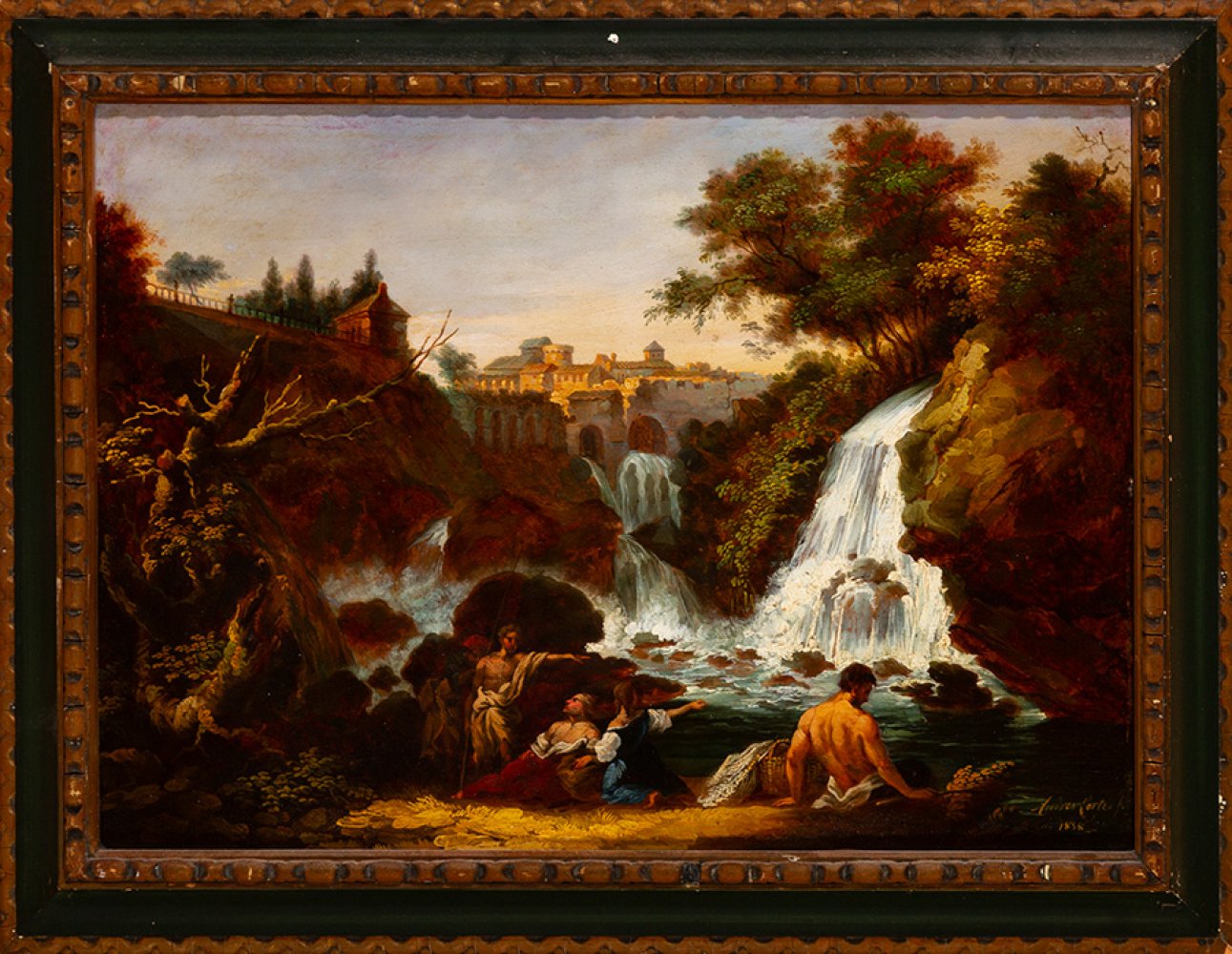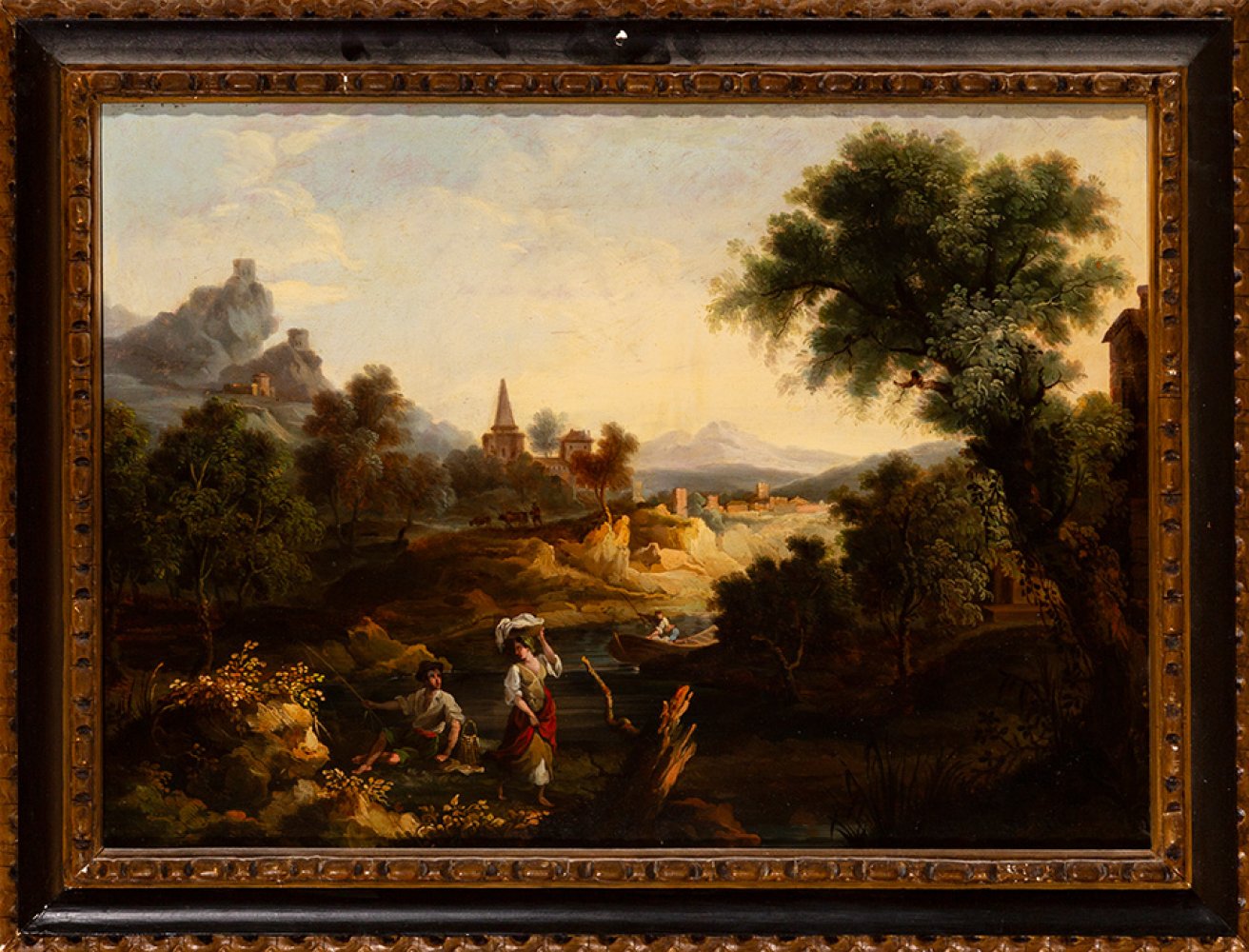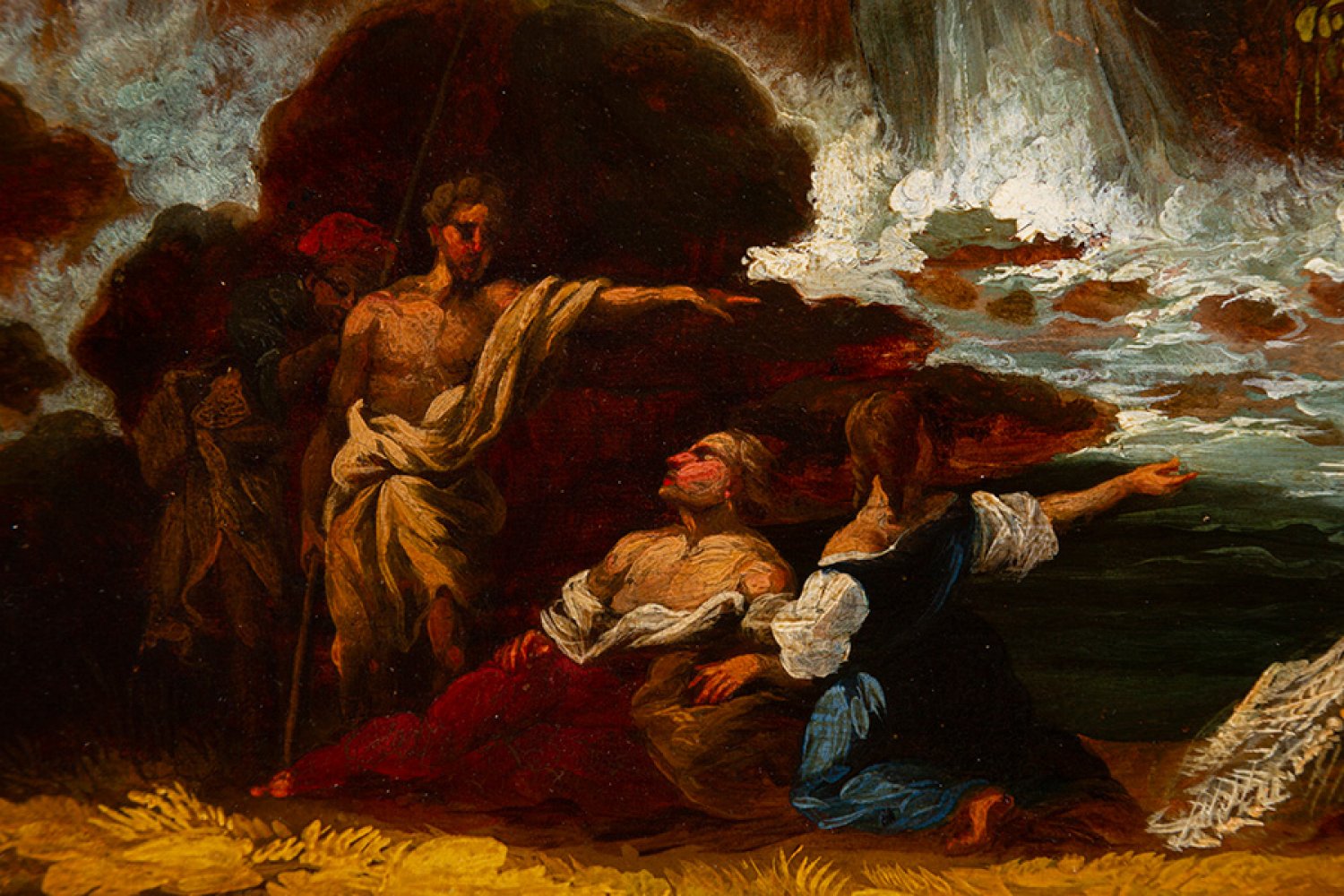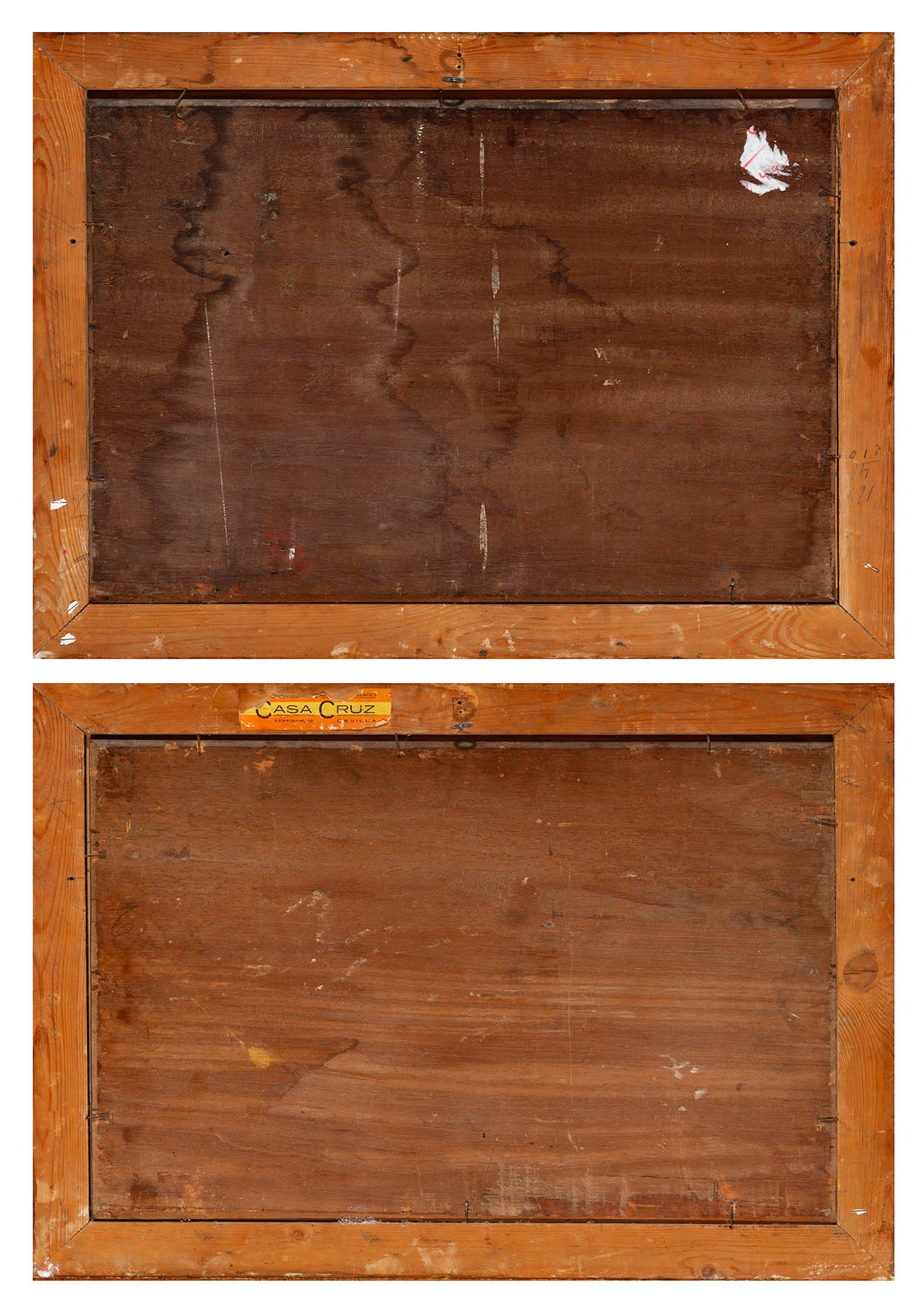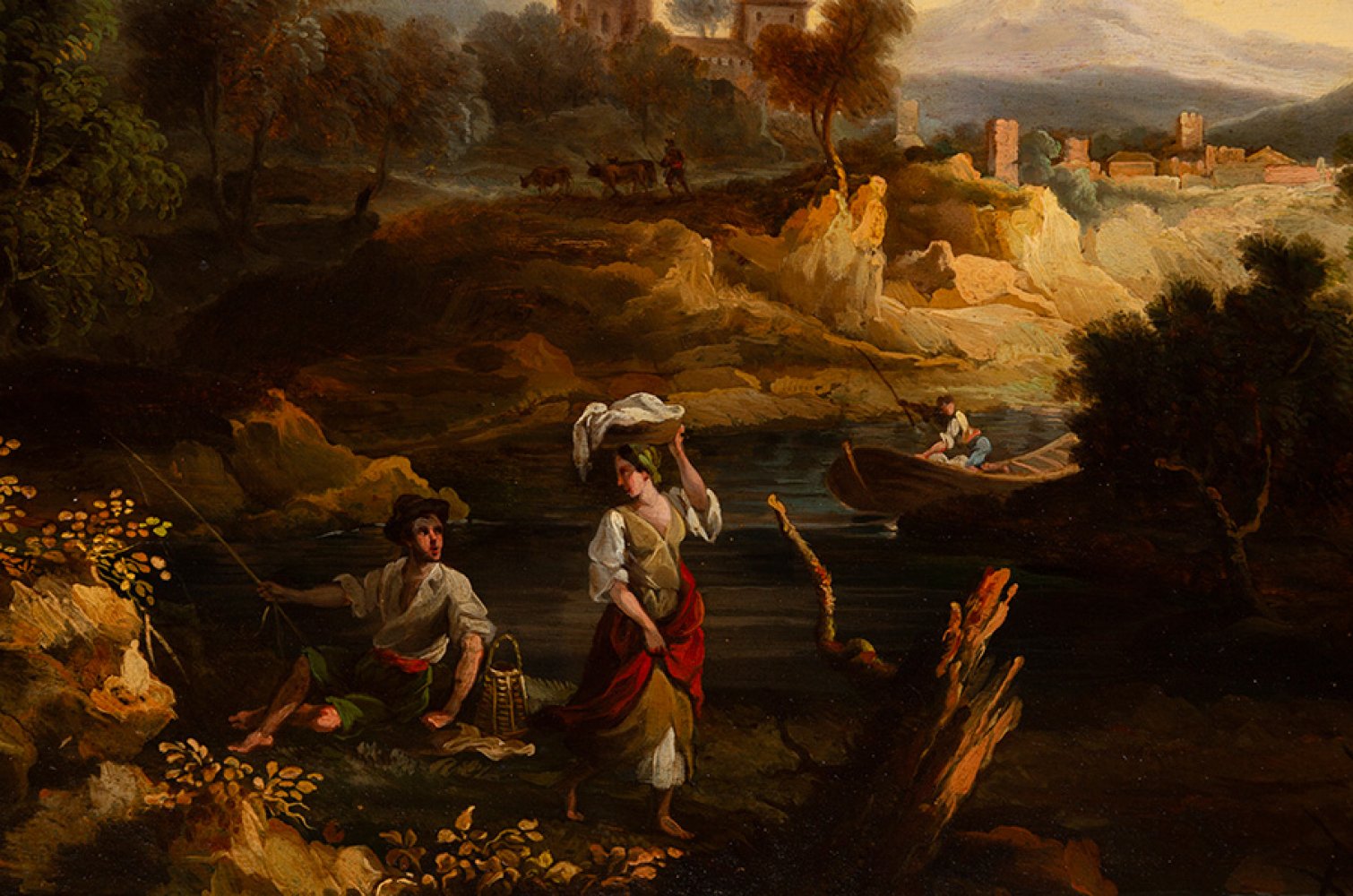10
ANDRÉS CORTÉS Y AGUILAR (Seville, 1812 - 1879)"Pair of Andalusian landscapes", 1858.Oil paintings on
1/7
Description
ANDRÉS CORTÉS Y AGUILAR (Seville, 1812 - 1879)
"Pair of Andalusian landscapes", 1858.
Oil paintings on panels.
One of them has a signature and date in the lower right-hand corner.
Measurements: 35.5 x 49.5 cm; 44.5 x 58 cm (frame).
A painter with a prolific and very personal oeuvre, however, there is little precise information about his life. His father, Antonio Cortés, lived in France and had been a disciple of the landscape and animal painter Constantin Troyon (1810-1865), which undoubtedly must have marked from his first artistic steps, together with his father, Andrés Cortés's preference for painting landscapes with herds, a genre in which he would become one of the most outstanding specialists of his time and which defines much of his production. He was present in Seville from 1840, where he lived all his life and furthered his career. He taught at the School of Fine Arts and was a member of its Academy from 1862, soon achieving fame in Sevillian artistic circles with his attractive panoramic views of the city with figures, for which he is best known today and which earned him a notable reputation in his day among the clientele of Seville's high society. Among them, the most famous are undoubtedly his versions of The Seville Fair, the first painted for the Count of Ybarra, the promoter of this popular livestock fair, and the other, signed in 1852, which is kept in the Bilbao Museum of Fine Arts. Within the same genre, Andrés Cortés painted other Sevillian views of an equally ambitious composition, with an emphasis both on the description of buildings and monuments and on the types and costumes of the people who inhabit them, with lively, brilliant colouring, aspects that are largely responsible for their appeal. However, most of the artist's best-known paintings, and the ones with which he must have maintained his career owing to their easy sale and decorative picturesqueness, were rural landscapes with flocks, almost always sheep or cow herds led by their shepherds, good examples are Camino de la Feria (Seville, Count of Aguiar), Paisaje con pastores y ganado (Palma del Condado, Cepeda collection), Paisaje de fantasía (Madrid, Fundación Santamarca), and the landscapes with figures in the Carmen Thyssen-Bornemisza Collection. He also painted some discreet portraits, such as those of Nicolás Antonio (Seville, Biblioteca Colombina), signed in 1851; José María Ybarra (Seville, Count of Ybarra), painted in 1854; and Rodrigo Ponce de León, Marquis of Cádiz (Seville, City Hall), signed two years later. He was also an interesting type painter, an example of which is The Uncle Gamboa of Hinojos (private collection), painted in 1857, and The Woodcutter Sewing His Clothes (Seville, private collection). He is also known to have painted religious works such as La caridad de las Hermanas de San Vicente de Paúl ("The Charity of the Sisters of Saint Vincent de Paul", Seville, City Hall; on loan to the Hogar de la Virgen de los Reyes), executed in 1847, and we also know of a large historical canvas painted by Cortés in 1848 depicting Guzmán el Bueno arming his son, which received some coverage in the Sevillian press of the time and was acquired by the Duke and Duchess of Montpensier. A participant in the Fine Arts exhibitions held in the city, in 1858 he was awarded a silver medal for A Country, and in 1868 he presented A Cabin. The recognition he enjoyed in his city showered him with local honours and distinctions, and he became a founding member of the Seville Archaeological Deputation, president of its Arts class, correspondent of the Royal Academy of Archaeology and Geography of Prince Alfonso and of that of Cordoba, and a member of the Academy of Emulation and Promotion, as well as being decorated with several crosses.
"Pair of Andalusian landscapes", 1858.
Oil paintings on panels.
One of them has a signature and date in the lower right-hand corner.
Measurements: 35.5 x 49.5 cm; 44.5 x 58 cm (frame).
A painter with a prolific and very personal oeuvre, however, there is little precise information about his life. His father, Antonio Cortés, lived in France and had been a disciple of the landscape and animal painter Constantin Troyon (1810-1865), which undoubtedly must have marked from his first artistic steps, together with his father, Andrés Cortés's preference for painting landscapes with herds, a genre in which he would become one of the most outstanding specialists of his time and which defines much of his production. He was present in Seville from 1840, where he lived all his life and furthered his career. He taught at the School of Fine Arts and was a member of its Academy from 1862, soon achieving fame in Sevillian artistic circles with his attractive panoramic views of the city with figures, for which he is best known today and which earned him a notable reputation in his day among the clientele of Seville's high society. Among them, the most famous are undoubtedly his versions of The Seville Fair, the first painted for the Count of Ybarra, the promoter of this popular livestock fair, and the other, signed in 1852, which is kept in the Bilbao Museum of Fine Arts. Within the same genre, Andrés Cortés painted other Sevillian views of an equally ambitious composition, with an emphasis both on the description of buildings and monuments and on the types and costumes of the people who inhabit them, with lively, brilliant colouring, aspects that are largely responsible for their appeal. However, most of the artist's best-known paintings, and the ones with which he must have maintained his career owing to their easy sale and decorative picturesqueness, were rural landscapes with flocks, almost always sheep or cow herds led by their shepherds, good examples are Camino de la Feria (Seville, Count of Aguiar), Paisaje con pastores y ganado (Palma del Condado, Cepeda collection), Paisaje de fantasía (Madrid, Fundación Santamarca), and the landscapes with figures in the Carmen Thyssen-Bornemisza Collection. He also painted some discreet portraits, such as those of Nicolás Antonio (Seville, Biblioteca Colombina), signed in 1851; José María Ybarra (Seville, Count of Ybarra), painted in 1854; and Rodrigo Ponce de León, Marquis of Cádiz (Seville, City Hall), signed two years later. He was also an interesting type painter, an example of which is The Uncle Gamboa of Hinojos (private collection), painted in 1857, and The Woodcutter Sewing His Clothes (Seville, private collection). He is also known to have painted religious works such as La caridad de las Hermanas de San Vicente de Paúl ("The Charity of the Sisters of Saint Vincent de Paul", Seville, City Hall; on loan to the Hogar de la Virgen de los Reyes), executed in 1847, and we also know of a large historical canvas painted by Cortés in 1848 depicting Guzmán el Bueno arming his son, which received some coverage in the Sevillian press of the time and was acquired by the Duke and Duchess of Montpensier. A participant in the Fine Arts exhibitions held in the city, in 1858 he was awarded a silver medal for A Country, and in 1868 he presented A Cabin. The recognition he enjoyed in his city showered him with local honours and distinctions, and he became a founding member of the Seville Archaeological Deputation, president of its Arts class, correspondent of the Royal Academy of Archaeology and Geography of Prince Alfonso and of that of Cordoba, and a member of the Academy of Emulation and Promotion, as well as being decorated with several crosses.
Auction Details
Shipping
T&Cs & Important Info
Ask seller a question
ANDRÉS CORTÉS Y AGUILAR (Seville, 1812 - 1879)
"Pair of Andalusian landscapes", 1858.
Oil paintings on panels.
One of them has a signature and date in the lower right-hand corner.
Measurements: 35.5 x 49.5 cm; 44.5 x 58 cm (frame).
A painter with a prolific and very personal oeuvre, however, there is little precise information about his life. His father, Antonio Cortés, lived in France and had been a disciple of the landscape and animal painter Constantin Troyon (1810-1865), which undoubtedly must have marked from his first artistic steps, together with his father, Andrés Cortés's preference for painting landscapes with herds, a genre in which he would become one of the most outstanding specialists of his time and which defines much of his production. He was present in Seville from 1840, where he lived all his life and furthered his career. He taught at the School of Fine Arts and was a member of its Academy from 1862, soon achieving fame in Sevillian artistic circles with his attractive panoramic views of the city with figures, for which he is best known today and which earned him a notable reputation in his day among the clientele of Seville's high society. Among them, the most famous are undoubtedly his versions of The Seville Fair, the first painted for the Count of Ybarra, the promoter of this popular livestock fair, and the other, signed in 1852, which is kept in the Bilbao Museum of Fine Arts. Within the same genre, Andrés Cortés painted other Sevillian views of an equally ambitious composition, with an emphasis both on the description of buildings and monuments and on the types and costumes of the people who inhabit them, with lively, brilliant colouring, aspects that are largely responsible for their appeal. However, most of the artist's best-known paintings, and the ones with which he must have maintained his career owing to their easy sale and decorative picturesqueness, were rural landscapes with flocks, almost always sheep or cow herds led by their shepherds, good examples are Camino de la Feria (Seville, Count of Aguiar), Paisaje con pastores y ganado (Palma del Condado, Cepeda collection), Paisaje de fantasía (Madrid, Fundación Santamarca), and the landscapes with figures in the Carmen Thyssen-Bornemisza Collection. He also painted some discreet portraits, such as those of Nicolás Antonio (Seville, Biblioteca Colombina), signed in 1851; José María Ybarra (Seville, Count of Ybarra), painted in 1854; and Rodrigo Ponce de León, Marquis of Cádiz (Seville, City Hall), signed two years later. He was also an interesting type painter, an example of which is The Uncle Gamboa of Hinojos (private collection), painted in 1857, and The Woodcutter Sewing His Clothes (Seville, private collection). He is also known to have painted religious works such as La caridad de las Hermanas de San Vicente de Paúl ("The Charity of the Sisters of Saint Vincent de Paul", Seville, City Hall; on loan to the Hogar de la Virgen de los Reyes), executed in 1847, and we also know of a large historical canvas painted by Cortés in 1848 depicting Guzmán el Bueno arming his son, which received some coverage in the Sevillian press of the time and was acquired by the Duke and Duchess of Montpensier. A participant in the Fine Arts exhibitions held in the city, in 1858 he was awarded a silver medal for A Country, and in 1868 he presented A Cabin. The recognition he enjoyed in his city showered him with local honours and distinctions, and he became a founding member of the Seville Archaeological Deputation, president of its Arts class, correspondent of the Royal Academy of Archaeology and Geography of Prince Alfonso and of that of Cordoba, and a member of the Academy of Emulation and Promotion, as well as being decorated with several crosses.
"Pair of Andalusian landscapes", 1858.
Oil paintings on panels.
One of them has a signature and date in the lower right-hand corner.
Measurements: 35.5 x 49.5 cm; 44.5 x 58 cm (frame).
A painter with a prolific and very personal oeuvre, however, there is little precise information about his life. His father, Antonio Cortés, lived in France and had been a disciple of the landscape and animal painter Constantin Troyon (1810-1865), which undoubtedly must have marked from his first artistic steps, together with his father, Andrés Cortés's preference for painting landscapes with herds, a genre in which he would become one of the most outstanding specialists of his time and which defines much of his production. He was present in Seville from 1840, where he lived all his life and furthered his career. He taught at the School of Fine Arts and was a member of its Academy from 1862, soon achieving fame in Sevillian artistic circles with his attractive panoramic views of the city with figures, for which he is best known today and which earned him a notable reputation in his day among the clientele of Seville's high society. Among them, the most famous are undoubtedly his versions of The Seville Fair, the first painted for the Count of Ybarra, the promoter of this popular livestock fair, and the other, signed in 1852, which is kept in the Bilbao Museum of Fine Arts. Within the same genre, Andrés Cortés painted other Sevillian views of an equally ambitious composition, with an emphasis both on the description of buildings and monuments and on the types and costumes of the people who inhabit them, with lively, brilliant colouring, aspects that are largely responsible for their appeal. However, most of the artist's best-known paintings, and the ones with which he must have maintained his career owing to their easy sale and decorative picturesqueness, were rural landscapes with flocks, almost always sheep or cow herds led by their shepherds, good examples are Camino de la Feria (Seville, Count of Aguiar), Paisaje con pastores y ganado (Palma del Condado, Cepeda collection), Paisaje de fantasía (Madrid, Fundación Santamarca), and the landscapes with figures in the Carmen Thyssen-Bornemisza Collection. He also painted some discreet portraits, such as those of Nicolás Antonio (Seville, Biblioteca Colombina), signed in 1851; José María Ybarra (Seville, Count of Ybarra), painted in 1854; and Rodrigo Ponce de León, Marquis of Cádiz (Seville, City Hall), signed two years later. He was also an interesting type painter, an example of which is The Uncle Gamboa of Hinojos (private collection), painted in 1857, and The Woodcutter Sewing His Clothes (Seville, private collection). He is also known to have painted religious works such as La caridad de las Hermanas de San Vicente de Paúl ("The Charity of the Sisters of Saint Vincent de Paul", Seville, City Hall; on loan to the Hogar de la Virgen de los Reyes), executed in 1847, and we also know of a large historical canvas painted by Cortés in 1848 depicting Guzmán el Bueno arming his son, which received some coverage in the Sevillian press of the time and was acquired by the Duke and Duchess of Montpensier. A participant in the Fine Arts exhibitions held in the city, in 1858 he was awarded a silver medal for A Country, and in 1868 he presented A Cabin. The recognition he enjoyed in his city showered him with local honours and distinctions, and he became a founding member of the Seville Archaeological Deputation, president of its Arts class, correspondent of the Royal Academy of Archaeology and Geography of Prince Alfonso and of that of Cordoba, and a member of the Academy of Emulation and Promotion, as well as being decorated with several crosses.
31st August -19th & 20th Century Arts
Sale Date(s)
Venue Address
Aragón 346, Barcelona
Calle Velázquez 7, Madrid
Carrer de Cirilo Amorós 55, Valencia
Barcelona
08009
Spain
General delivery information available from the auctioneer
Setdart offers Worldwide shipping
PICK UP IN ROOM: You can come and pick up your lots in our offices (Barcelona, Madrid or Valencia). At the moment of the withdrawal, you will be able to accept the current conditions of the lot by means of a document that you will sign.
YOU CAN SEND ANOTHER PERSON TO PICK UP: This person must present a signed authorization that you can find in our web page by accessing from BUY AT SETDART- LOGISTICS-DOWNLOAD AUTHORIZATION DOCUMENT. You can also send an e-mail with the requested data in AUTHORIZATION DOCUMENT to admin@setdart.com
Important Information
25% buyer´s premium
21% buyer´s premium at www.setdart.com















